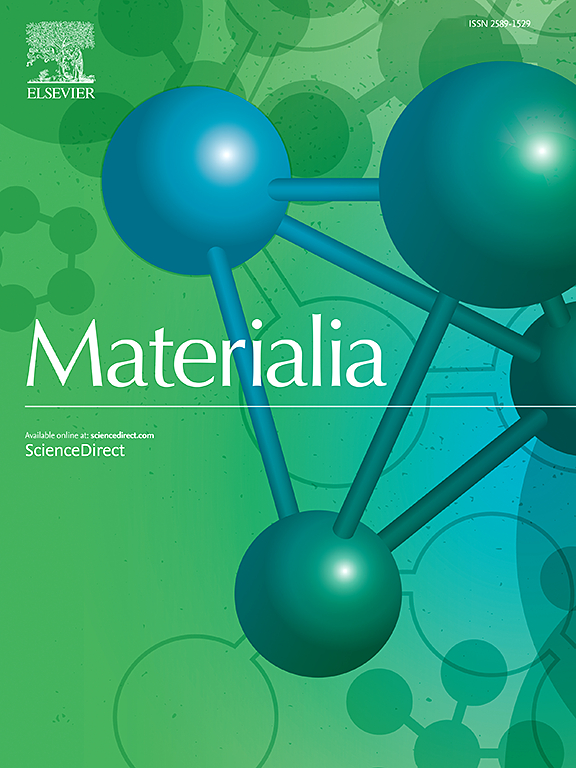Structure, thermal stability and microstructural properties of Bi4V2-x(Cu-Li)xO11-7x/4 solid solution (0.1 ≤ x ≤ 0.3)
IF 3
Q2 MATERIALS SCIENCE, MULTIDISCIPLINARY
引用次数: 0
Abstract
The structural, thermal, and spectroscopic properties of Bi4V2-x(Cu-Li)xO11-7x/4 (0.1 ≤ x ≤ 0.5) compounds were investigated to explore the effects of copper and lithium substitution on the material's crystalline structure and phase transitions. X-ray diffraction (XRD) analysis revealed that increasing the substitution level from x = 0.1 to x = 0.3 resulted in phase transitions from monoclinic to orthorhombic, and eventually to tetragonal, with the solid solution limit at x = 0.3. The crystallinity and porosity showed an inverse relationship as the substitution rate increased, with crystallite size enlarging from x = 0.1 to x = 0.2, and a defect-trapping effect at higher substitutions (x = 0.3 and x = 0.4). Differential thermal analysis (DTA) and thermogravimetric analysis (TG) indicated significant endothermic transitions, with a peak at 698°C corresponding to the melting of a secondary phase isostructural to Bi8V2O17. High-temperature XRD (HT-XRD) analysis further supported the phase transitions, while Raman spectroscopy showed shifts in the V-O bond stretching vibrations with increasing substitution. The study concluded that substitution with copper and lithium modifies the thermal stability, crystallinity, and phase behaviour of BiCuLiVOx compounds, highlighting their potential in various applications requiring high-temperature stability and ionic conductivity.

Bi4V2-x(Cu-Li)xO11-7x/4固溶体(0.1≤x≤0.3)的结构、热稳定性及显微组织性能
研究了Bi4V2-x(Cu-Li)xO11-7x/4(0.1≤x≤0.5)化合物的结构、热学和光谱性质,探讨了铜和锂取代对材料晶体结构和相变的影响。x射线衍射(XRD)分析表明,从x = 0.1增加到x = 0.3,取代水平的增加会导致相变从单斜晶向正交晶转变,最终转变为四方晶,固溶极限在x = 0.3。结晶度和孔隙度随取代率的增加呈反比关系,晶体尺寸从x = 0.1增大到x = 0.2,在取代率较高时(x = 0.3和x = 0.4)存在缺陷捕获效应。差热分析(DTA)和热重分析(TG)显示了明显的吸热转变,在698°C处有一个峰值,对应于Bi8V2O17的次级相等结构的熔化。高温XRD (HT-XRD)分析进一步支持了相变,而拉曼光谱显示,随着取代的增加,V-O键的拉伸振动发生了变化。该研究的结论是,铜和锂的取代改变了BiCuLiVOx化合物的热稳定性、结晶度和相行为,突出了它们在需要高温稳定性和离子导电性的各种应用中的潜力。
本文章由计算机程序翻译,如有差异,请以英文原文为准。
求助全文
约1分钟内获得全文
求助全文
来源期刊

Materialia
MATERIALS SCIENCE, MULTIDISCIPLINARY-
CiteScore
6.40
自引率
2.90%
发文量
345
审稿时长
36 days
期刊介绍:
Materialia is a multidisciplinary journal of materials science and engineering that publishes original peer-reviewed research articles. Articles in Materialia advance the understanding of the relationship between processing, structure, property, and function of materials.
Materialia publishes full-length research articles, review articles, and letters (short communications). In addition to receiving direct submissions, Materialia also accepts transfers from Acta Materialia, Inc. partner journals. Materialia offers authors the choice to publish on an open access model (with author fee), or on a subscription model (with no author fee).
 求助内容:
求助内容: 应助结果提醒方式:
应助结果提醒方式:


